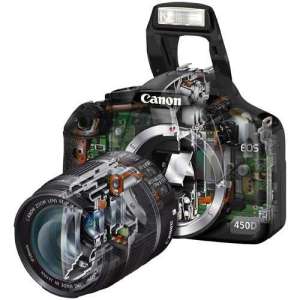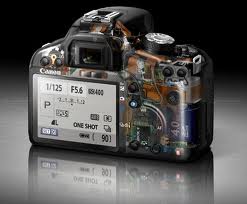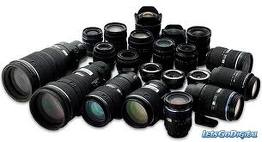1. Eyepiece (base currency) = holder for our eyes while looking into the viewfinder.
2. Viewfinder (viewfinder) = viewfinder using the method pentaprisma (pentagon shape) which is placed
above the optical path through the lens to the image sensor plate. incoming light then reflected upward by a mirror (mirror reflection) and the pentaprisma. pentaprisma then reflects light several times through the
viewfinder (viewfinder). When the shutter button is released, the glass opens the way for the light so that light can directly on the image sensor.
3. Image sensor (sensor image capture) = a sensor that is used to process and capture an image contained in
a camera. size there are a variety of sensors, ie APS-C sized 15x23mm, 19x29mm APS-H size, and
FULL-FRAME 24x36mm (with large size movie).
4. Flash (light like blits) = flash is usually used to help us in taking photographs in the dark.
5. Hotshoe (flash external holder) = a holder for an external flash that is usually located in the middle of the
camera body.
6 .Lens (lens) = a lens mount that is embedded in the camera body (lens body can be removed and replaced dr) that serves to focus the light to be able to captured by the image sensor. on the outside of the lens there is usually a three-ring, which ring the focal length (for variable type lenses), aperture ring and focus ring. there are 5 characters that lens, wide (wide), macros (enlarge), telephoto (zoom), tilt & shift and fish eye. and there are 2 types of lens fix (can not be changed, such as 50mm) and zoom (there rangenya like, 17-85mm). lenses also have a feature is (image stabilizer) to dampen vibration of the hand and USM (ultrasonic motor) to accelerate the search and silent focusing. * Code type is usm canon DLSR cameras. these features in any other DSLR camera lenses also exist, but the code name of the other but with the same function. 7. Lenshood = an addition on the lens to reduce excess light, the impact of flares and a protective front surface of the lens, and also as an addition to the display lens to look more frightening. * Remember: the use of hood that does not correspond to the series lenses will cause vignetting (vignetting = black spots on the sides of the tip of the image).
8. LCD monitor (LCD display) = to view images and monitor the results of modes that we use to take pictures.
9 .Focal point = if you look into the viewfinder, then you'll see a tiny dots scattered (the number of points
depending on the type and model of camera) where the focal point for helping you find focus images would
be taken.
Source: http://kerjaanrimba.wordpress.com





0 comments:
Post a Comment